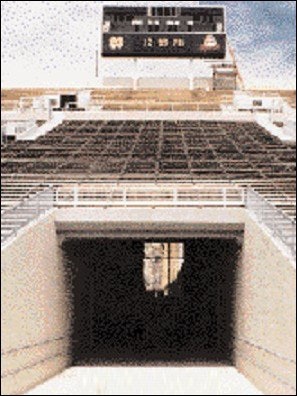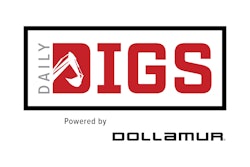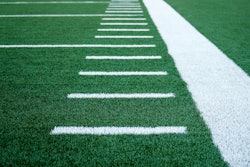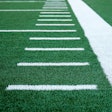Implementing a regular program of inspection, testing and maintenance procedures can ensure that aging facilities don't fall into disrepair

The 1970s saw a peak in the construction of new sports facilities on college campuses. It was a time when college sports was becoming a big business, and schools realized that building modern facilities was imperative to their success. Today, those facilities have become dinosaurs when compared to newer structures. Although many are quite serviceable, some have deteriorated to the point that they pose serious maintenance and safety problems. (Although last year's highest-profile structural failure - the falling beam at Yankee Stadium - was outside the college realm, it provides sufficient illustration of the dangers involved.)
There are numerous threats to the structural integrity of a sports facility, including natural occurrences such as rain, wind, snow, temperature variations, foundation settlement and, more obviously, earthquakes. If these aren't taken seriously - if problems aren't taken care of as soon as they've been found to infiltrate a facility's structure - they'll only continue to increase in scope. Fortunately, there are plenty of ways to physically maintain a facility. Stadiums can be used for a long, long time, assuming they are suitably maintained.
From an engineering standpoint, sports facilities are designed and built to last for at least 50 years. From the outset, engineers typically design a stadium based on worst-case scenarios that might occur during a 50-year period of time. Elements such as historical temperatures and snowfall measurements are evaluated, naturally, but the standards the stadium is built to withstand result from the worst, or most threatening, events that may occur during that time. Of course, this standard design time frame does not mean that a facility will reach the end of its structural usefulness at 50 years. The worst-case scenario may not occur in that time frame, and even if it does, proper repair and maintenance can continue the useful life of a facility indefinitely.
A primary culprit in a facility's deterioration is water - and it doesn't only come from rain or snowstorms. It can come from humidity and condensation resulting from improper insulation, vapor barriers or ventilation, particularly in a natatorium environment. It can also come from normal cleaning and maintenance programs. Most stadiums undergo "washdowns" where soda spills, dirt and trash are removed from floors and walls with power washing equipment. This practice, while necessary, causes high-pressure water to penetrate the structure. It can seep into cracks throughout the facility, causing corrosion to steel substructures and (because of the expansion of water when it freezes) freeze/thaw problems that can increase cracking and deterioration. Water can also cause damaging ground movement if it gets into soils around a facility's foundation. The resulting instability can create fractures in the structure that may be difficult to detect under the stadium's surface.
Movement can cause other problems for the stadium structure. If there aren't enough expansion joints in place, the force of the movement will cause cracks in walls, ceilings and floors. Even "x-braces" that are used to resist a building's lateral forces can easily be ruined by this unexpected movement.
Specific areas in a stadium that are at risk from vertical or lateral movement include rigid sections such as those commonly (but not appealingly) known as "vomitories" (where the building "disgorges" its spectators, according to the word's Latin derivation). This is especially problematic for unheated interiors or outdoor stadiums, where daylight or seasonal temperature changes expand and contract the structure, with areas exposed to sun naturally expanding from the heat while shaded areas remain stable. These opposing forces can result in fairly significant damage, particularly if expansion joints haven't been specified for these areas.
Another threat to stadiums - especially those with more enthusiastic users - is misuse. Spectators jumping up and down, shaking rails, kicking seats and stomping their feet can do a considerable amount of damage to a facility. (So can careless forklift drivers.) Although most facilities are built to withstand the excitement of a sporting event and the mass movement of people and supplies, a facility's users can create costly damage.
Just as sports facilities face a variety of potential perils, there are a number of areas where potential problems can be mitigated:
• Appropriate design. If a stadium design is about to begin, or is underway, make sure that the correct criteria are being applied. This includes knowing the appropriate design standards and use of the facility, and understanding the best materials to use for the given conditions.
• Materials usage. Specifying good materials is an obvious place to start, but where to use the best materials is also vitally important. For example, make sure that the walls fronting areas that get a lot of harsh use (corridors and rest rooms) are of a hard, durable surface that can be easily maintained. If you are attempting to save some money on materials, choose the right places to do it.
• Corrosion protection. Metals exposed to water that are not accessible for maintenance should be galvanized or similarly protection-treated. This will help prevent corrosion and inhibit leaking that is hidden and not maintainable by painting.
• Paint. Steel rails and beams, and other exposed surfaces, should be properly prepared and coated with a quality primer and then painted. Applying a fresh coat of paint every few years, over the top of a quality primer, will be far more cost-effective than being faced with the possibility of having to replace a structure in part or in whole - or repainting that could involve new surface preparation (sandblasting).
• Attention to detail. A rapidly designed and constructed facility can look as nice as a detailed stadium from the outset. Once the crowds arrive, however, it won't be long before it takes on a far different appearance. Materials such as concrete and steel may seem indestructible regardless of how they're implemented into a design, but that's far from the case when they're called to withstand thousands of fans, as well as natural forces.
For example, trying to put a steel post on a thin concrete section will, over time, cause cracking and crumbling of the concrete. Likewise, rails at a concessions stand can be applied to the floor in a number of ways. If they're simply bolted to the floor surface, constant leaning and grabbing by crowds of people will eventually cause them to loosen and break. A more sturdy and lasting design, even though it may require additional waterproofing, involves running the posts down through the floor to the structure's base.
• Expansion joints. Improperly designed, constructed and maintained expansion joints are the number-one source of leaks into stadiums. Expansion joints, while they provide flexibility and relief against stresses caused by building movement, should be limited to whatever extent possible to prevent potential leaking.
• Sealants and membranes. Sealants and membranes are a critical defense against water damage. Concessions-area floors should be sealed with an elastomeric coating (a liquid-applied membrane that can go on the floor and be drawn up walls to create a mini-bathtub effect). This will not only deter water leaks, but will also help keep the area sanitary. Waterproofing should also be used on metal decks and ramps where water can leak through the concrete surface onto the metal deck, causing rust. It's critical that sealants be used in the concrete joints in order to keep water on the surface. Remember, concrete is porous and can absorb significant amounts of water if not properly sealed.
• Concrete mixes. There are many types of concrete mixes available for use in construction. Many help control and deter extensive cracking in concrete surfaces. For example, fibrous reinforcement can be mixed into concrete to distribute cracking and ensure that cracks remain hairline cracks. Silica Fume can be mixed with concrete to increase density, thereby leaving little room for air pockets. This creates a less porous surface and thus keeps more water out. Corrosion inhibitors in concrete will protect steel within concrete slabs from rust caused by deicers.
• Quality control. The very best materials can be selected and the most detailed designs can be drawn, but proper implementation is required. Selecting an experienced and professional general contracting firm that understands how to construct a quality facility is imperative. The contractor should also be a part of the design effort to share ideas and input from the start of a project. Frequent testing and inspection of materials and workmanship by a testing and inspection agency will also contribute to a quality finished product.
• Load limits. Overloading the structure may have caused a balcony to collapse at a Russian sporting event last year. Similarly, a heavy forklift that was moving items on the rooftop of a Chicago supermarket may have caused that roof's collapse during the same week. It's important that the loads entering the upper concourses of a stadium be checked, and that load limits be posted. This is especially true in storage areas and where access for tugs and forklifts is required.
Once a stadium has been built and the features are all in place, the program to maintain its appearance and serviceability must begin. Confidence in the facility's ability to withstand the worst weather and harshest use doesn't make it indestructible, nor does it enable the facility to take care of itself. An ongoing, quality maintenance program should be implemented to promote awareness of any problems as they arise and allow for early and less costly repairs to be made. If a facility goes unchecked for too long, it will slowly degrade to the point where rehabilitation is unfeasible or cost-prohibitive.
The following areas must be given attention during the implementation of a maintenance program:
• Budget. Don't neglect to budget for the entire maintenance program. Although it may reduce some of the revenue the facility generates, it will save money in the long run. Some of the items to budget for include a maintenance crew, checks of the facility for structural problems, mechanical/electrical systems, and materials such as roofing, paint and sealants. Facilities need regular checkups and maintenance, just like a car.
• Damage control. If damage is discovered, take action immediately. Even the smallest surface cracks may be the start of a more major problem unless they're repaired. Prior to making repairs, make sure that the damage hasn't progressed to ensure the repair work doesn't cover up other growing problems.
• Problem areas. Certain areas of a facility require more attention than others. For example, long-span roofs collect substantial amounts of snow and water. They should be checked regularly for cracks and deflections. Many of the problems on a roof will be found at its edges, where water and snow are likely to collect and cracking is most likely to start. The roof will also give clues to problems on the ground such as settling, since problems down below will be magnified at the rooftop. Not only will an unchecked weak or leaking roof add to the cost of repairs, it also may pose a significant safety hazard.
• Staff education. Everyone associated with the stadium should be educated about how to maintain the facility. Cleaning crews should know that if they discover pieces of concrete or bolts on the ground, water damage or some other sign of trouble, a supervisor should be notified. Make it clear that such discoveries may be an early sign of a serious problem.
• Record-keeping. Keep track of maintenance and repairs. Document observations such as water damage or cracks and their progress. These may be helpful in finding problems that need to be remediated.
• The walk-through. This non-intrusive inspection should take place frequently. During a walk-through, experienced architects and engineers will be able to identify potential problems that others might overlook. This can include any evidence of movement, such as tilted sidewalks, cracks in the exterior and stress in the building's skin. They also can inspect expansion joints in order to identify how much they've moved (evidenced by a pinched or expanded joint).
Examples of problems discovered during walk-throughs are plentiful. In one instance, an office area had been turned into a storage room by a stadium's staff. The upper floor space hadn't been designed to support the weight of the equipment being stored in the room, and it risked collapse. In another instance, granules were found in a corridor of a brand-new stadium. Upon further investigation, engineers were able to see that neoprene pads placed between some of the trusses above were being worn down by the grinding of the trusses. Another problem involved new spotlight platforms that had been installed in an older area. The heavy platforms had been hung directly from a steel beam at the ceiling, creating a bow in the beam. Left unchecked, a catastrophe may have resulted.
If exterior problems exist, and give engineers reason to believe that more serious trouble has developed within a structure, intrusive tests can be performed. These tests can range from the use of chemicals to gauge the age and composition of concrete material, to materials examination or strength-testing of core samples of concrete or masonry. Likewise, steel can be tested by shaving off a piece of steel (called a "coupon" test) and checked for tensile strength. X-rays, ultrasound, vibration and deflection are also effective tests for checking a structure's condition, strength and stability.
Much has been written about stadium obsolescence in recent years, but the discussion has typically focused on closures resulting from functional deficiencies caused by a change in usage or programming. Many of the pro facilities replaced because of owners' insistence that they couldn't generate sufficient concessions, luxury-suite and advertising revenue (Atlanta-Fulton County Stadium springs to mind) were, in fact, still in outstanding physical shape when they fell to the wrecking ball.
Obsolescence resulting from physical deficiencies is one circumstance that can be resisted with the implementation of a sound inspection and maintenance program. In stadiums that haven't done so, problems are sure to arise that may eventually make them obsolete - and not just for financial reasons.




































